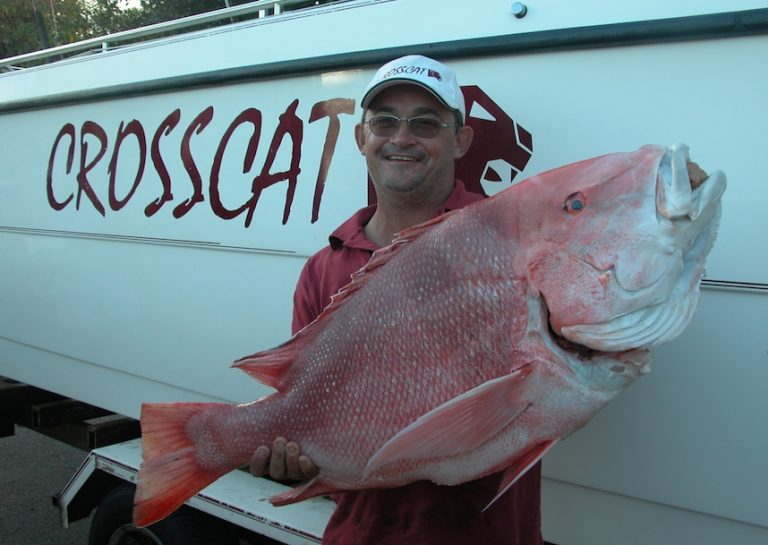Offshore 1770 – Wayne Baldry
So, you’ve arrived at 1770 after a big drive. The bearings didn’t fail and you’re itching and ready to go. The forecast looks good. Anything less than 15 knots allows you to get to plenty of country without too much drama.
You have some waypoints a mate has given you, he has caught red emperor here before. That’s great and a good start, but any good fisherman does not give good spots away so freely. So, before you leave the ramp, is there some good, fresh bait in your ice box?
“Cuttlefish, or good quality squid is essential”
Reds love cuttlefish heads and so do all the other quality reef fish you hope to catch. A box of pilchards too if you are chasing trout. Bait jigs to catch live bait, is also highly recommended. From about May onwards, large bait balls move in close and can be easily found if you keep an eye on your sounder. Three lanes at 1770 ramp to choose from, but if it’s good weather and neap tides, it’s going to be busy, prepare to wait your turn. Be wary, you may have to park on the roadside, as the carpark fills fast. Round Hill bar is relatively easy to cross, but like any bar crossing, keep an eye on the swells. More of a concern is the sandbar just inside the creek mouth which becomes very shallow on the big low tides. Lots of boats leave on the morning high tide only to return in the afternoon to find crossing this section, just past the first green buoy very difficult.
Now which reef to choose: Boult, Lamont, Fitzroy, Musgrave?
All of the bunker group have great potential, but it is not necessary to go over 30 nautical miles for good fishing. Ease the throttle back and look for country on the way out if time allows. Use the sonar menu to narrow the area that you are searching. Focus on the bottom third of the water column, you are looking for small holes or ledges. These holes and ledges are more prominent anywhere from five miles out. As you travel over the contour lines of your plotter, follow along the lines to enhance your chances of finding new country. These spots can be very small and conditions of wind and tide need to be compatible to allow anchorage. Drifting can also work well, if there is limited tidal run and not too much wind. Obviously, the bigger reefs out wider, will be easier to find and fish, but the rewards on lightly fished areas can be spectacular.
Live bait should be your “go to” bait, especially yakka’s. We put at least 50-60 into the live well, as I have crew members who try to pin the slippery little suckers at the side of the boat only to lose them over the side. To allow for mistakes, catch more than you think you need. Circle hooks in the 6/0 to 8/0 range pinned through the top of the fish just in front of the dorsal fin on a 45 degree angle, works well. This combined with 50-80 pound braid, tied to a swivel or straight to the leader by a slim beauty knot. Leader strength varies depending on tidal flow and finicky fish. 50 Lb. is bare minimum, mostly we use 100Lb., and crimp the hook to this with just a running sinker above the hook. By allowing the hook to move more freely, better hook-up rates can be achieved. A Paternoster rig with two droppers also works well, pin the live bait on the top hook to keep him swimming higher above the reef, allowing more visibility to tempt. A yakka in front of a big coral trout, is like an ice-cream sundae to my kids. If you are still having trouble getting a hit and your sounder is showing that you are on the right spot with good fish shows, put another live bait on the same hook, but pin this one just behind the anal fin. You have just added sprinkles to your ice-cream sundae; unresistable! When the live bait is about to get harassed, he develops a distinct “Oh crap” dance, as a big reefie moves in on him.
It may seem sacrilege, but the best flesh bait is often Spanish Mackerel, followed closely by Hussar and Iodine Bream. Don’t skimp on the bait size, pin on a big fillet threaded through once only, either end of the slab. Using Spanish Mackerel or Hussar, will be hard to do, as they are both delicious in their own right, but I would happily sacrifice either for a big Red Emperor, anytime.
This is a special part of the world, but be under no illusion that you can just throw a line over and hook up. Preparation and knowledge can go a long way and pay great dividends if you have the time and patience on your side. Good luck and enjoy your time on the water.





